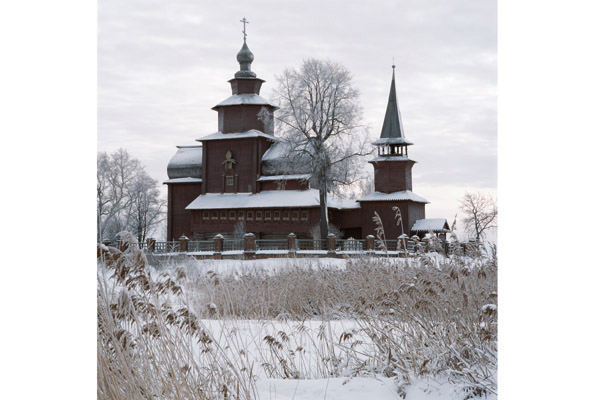This book, by the architectural historian Richard Davies, is remarkable in many ways — for the importance of its subject matter, for the excellence and variety of the many photographs, and for the imaginative choice of the accompanying texts. The fruit of ten years of long and difficult journeys in the far north of European Russia, it is a labour of love. It is also extremely informative.
Russian wooden churches are very varied; because it is difficult to travel over such often boggy terrain, each region tended to develop its own specific architectural features. All, however, are built from logs of hewn pine; the carpenters used neither saws nor hammers and nails — only axes. And they are crowned by onion domes or tent roofs whose aspen tiles have a silvery glint even in dull weather. Most of the churches are positioned on high points, so as to be clearly visible to distant travellers. The classic configuration is that of a troinik — a threesome, composed of a ‘summer church’, a smaller ‘winter church’, that is easier to heat, and a tall bell tower. Very few such threesomes survive.
With a little care, these churches can last for a surprisingly long time. Pines grow slowly in the far north, and so the logs cut from them are dense and strong; and hewn logs last longer than wood cut by saw. The rate of destruction of these churches has, however, been continually accelerating. Before 1917, there were many thousands of such churches; since then about 80 per cent have vanished. Some were destroyed during Soviet anti-religious campaigns, others in the war.
During the last 20 years, massive rural depopulation has proved still more destructive. Many churches have been ruined by accidental fires or rot-inducing leaks. Once a church has begun to fall apart, locals, desperate for firewood, are quick to finish the job of dismantling it. A French scholar I know, travelling by boat around northern Russia, was asked by an historian if she noticed anything unusual about a particular patch of ground on the outskirts of a village they were approaching. She could see nothing. He told her that he had seen an intact church standing there only ten years earlier; the only sign of its former presence was the abnormal flatness of the ground it had stood on.
The many brief texts Davies and Moreton quote are as remarkable as their photographs. There are striking written and oral accounts of the destruction of church bells in the 1920s, of icons being burnt or floated off down the river, of churches being turned into youth clubs, village cinemas or grain stores. We read how in the 1970s a woman told a Russian writer:
They turned the icons into horse-troughs… You’d be feeding a horse and you’d bend over the trough and get the fright of your life to see the face of Christ or the Virgin looking up at you. Such stern faces and big eyes — it made your heart stop beating.
The authors quote equally vivid evocations of peasant life in pre-revolutionary Russia. Stephen Graham, for example, writes in Undiscovered Russia (1912) that the peasant’s cradle
is a pine bole, scooped out like an ancient boat. His coffin is but a larger cradle, a larger, longer pine scooped out. And between the cradle and the coffin he lives surrounded by wood. He eats off wooden plates. Even the salt cellar is from the forest, and was plaited by his sister from reeds last year. He learns that the foliage of a tree takes shape according to the sunshine it gets and the time of day the sunshine reaches it, and when he is in the dark forest he knows by the shape of the trunk the way out. Every tree is a compass in itself.
Wooden Churches ends with an Afterword by Mikhail Milchik, of the St Petersburg Research Institute of Restoration. After stating that ‘Wooden architecture, the most original and unique part of the cultural heritage of Russia, is on the verge of total extinction,’ he refers to ‘the almost total indifference towards the fate of the national cultural heritage that reigns in Russian society from the top to the bottom.’
That said, it is worth mentioning the existence of a number of recent initiatives. Some are local; the ‘Society for Rural Churches’ is Moscow-based; and the ‘British Society for the Protection of Ancient Buildings’ is now collaborating with the ‘Moscow Architecture Preservation Society’, chaired by the knowledgeable and determined Clementine Cecil. Two useful websites may be found at specc.ie/moscow maps and specc.ie/churchgallery.






Comments